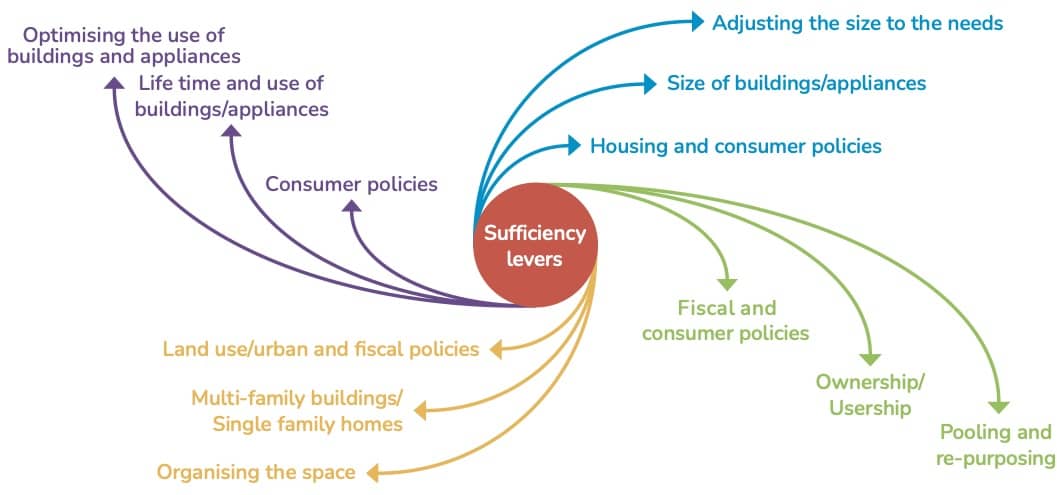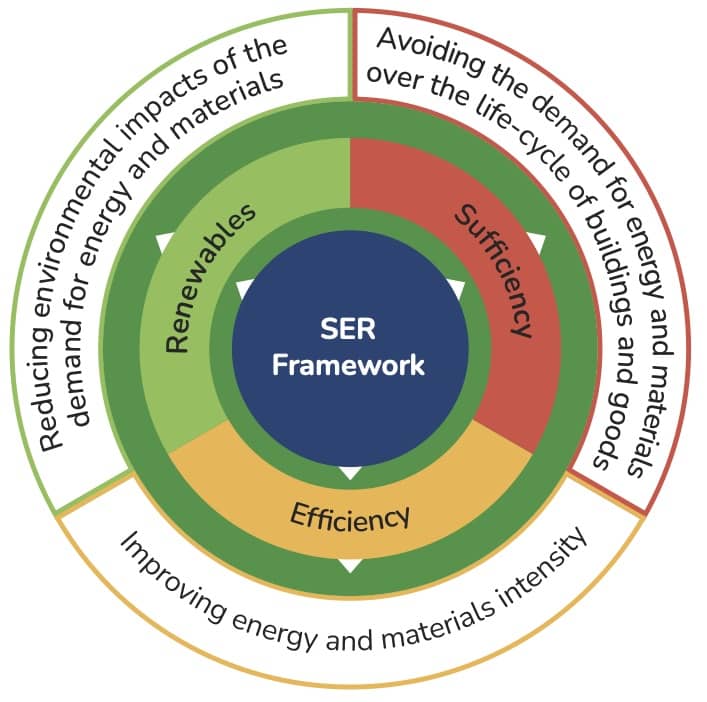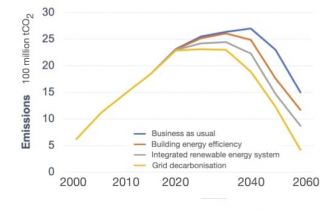
www.buildingsandcities.org/insights/commentaries/cop26-sufficiency.html
COP26: Sufficiency Should be First
By Yamina Saheb (Lausanne University, CH)
Avoiding the climate emergency requires going beyond the current set of policy measures. Instead, the concept of sufficiency needs to be adapted and applied to today's environmental and societal challenges. This would provide clear metrics that are equitable and within the Earth's ecological limits. The application of sufficiency to policies for building stock would provide a decent living standard for all and have a significant impact on limiting global warming.
The direct, indirect, and embodied CO2 emissions from the global building stock were above 14 Gt by 2020 (IEA 2021). This is almost double of 1990 emissions from buildings. Yet during the last three decades, there has been a worldwide acceleration of the adoption of building energy policies. The collective failure in significantly curbing emissions from buildings raises questions about whether the present approach to climate change mitigation policies is adequate and effective. Efficiency improvements, combined with the slow adoption of renewable energy and minor behavioural changes, are insufficient to deliver on the 1.5°C target.

Sufficiency is a set of policy measures and daily practices which avoid the demand for energy, materials, land, water, and other natural resources, while delivering wellbeing for all within planetary boundaries. Sufficiency bridges the inequality gap by setting clear consumption limits to ensure a fair access to space and resources. There are two sets of limits for sufficiency: an upper and lower boundary. The upper limit of sufficiency is the remaining carbon budget with its normative target for distributional equity. The lower limit of sufficiency is the provision of decent living standard's requirements. A decent living standard being a set of essential material preconditions for human wellbeing which includes housing, nutrition, basic amenities, health care, transportation, information, education, and public space (Rao et al. 2019; Rao & Baer 2012; Rao & Min 2018). In contrast to efficiency, which is about doing more with less in relative terms without considering planetary boundaries, sufficiency is about consuming less in absolute terms and within the biophysical limits of the planet (Princen 2003; Rees 2021). Sufficiency targets the needs for human wellbeing while efficiency satisfies human wants by providing more commodities.
Applying sufficiency principles to buildings requires i) optimising the use of buildings, ii) repurposing unused existing ones, iii) prioritising multi-family homes over single-family buildings and iv) adjusting the size of buildings to the evolving needs of households by downsizing dwellings (Figure 1) (Sandberg 2018; Stephan et al. 2013; Duffy 2009; Fuller & Crawford 2011; Wilson & Boehland 2005; McKinlay et al. 2019; Sandberg 2018; Huebner & Shipworth 2017; Ellsworth-Krebs 2020; Berrill et al. 2021).
Cohousing strategies, such as senior cooperative housing, communities and eco-villages are among the existing solutions to downsize dwellings (Kuhnhenn et al. 2020). In practice this leads to reducing the per capita floor area by providing users, in both new and existing buildings, with a shared space (i.e. for laundry, offices, guest rooms and dining rooms) to complement their private space. As a consequence, the consumption of resources including energy, materials, water and electricity is reduced leading to a reduction of both embodied and operational emissions (Klocker et al. 2012; Klocker 2017; Goldstein et al. 2020; Duffy 2009; Heinonen & Junnila 2014; Berrill & Hertwich 2021). Less space will also result in less appliances and equipment and alter preferences towards smaller ones (Aro 2020). Beyond emissions reduction, cohousing limits loneliness of elderly people and single parents (Riedy et al. 2019; Wankiewicz 2015).

Sufficiency measures are non-energy policies. Progressive property taxes based on a cap in the per-capita floor area are also needed to adapt the size of dwellings to households' needs (Murphy 2015). Local authorities have an important role to play in the metamorphosis of buildings by increasing the share of communal spaces (Williams 2008; Marckmann et al. 2012) through urban planning and land use policies (Duffy 2009; Newton et al. 2017). This can result in inter-generational cohousing and interactions between people with different social backgrounds (Lietaert 2010; Williams 2008).
In order to realise the full decarbonisation potential of the building stock, the design of climate mitigation policies must address the urgent metamorphosis of the global building stock by using the sufficiency, efficiency, and renewable (SER) framework (Figure 2). The first step towards this policy change is to provide policymakers with estimates of the sufficiency potential. Unfortunately, despite the growing literature on the crucial role of sufficiency in curbing emissions, most of the global scenarios aiming at 1.5°C target do not include sufficiency assumptions. On the contrary, these scenarios assume a linear increase of the per-capita floor area driven by affluence. Grubler et al. (2018), Millward-Hopkins et al. (2020) and Kuhnhenn et al. (2020) are among the few researchers working on global scenarios involving a cap in the per-capita floor area and a convergence between the Global North and South in the access to a decent living standard for all. The usual modelling methodologies lead to small tweaks to business-as-usual policies, which delay climate action. Overall, the unequivocal role of human activities in global warming is unlikely to be reduced unless sufficiency is made a primary principle in climate mitigation scenarios and policies.
References
Aro, R. (2020). 'A bigger living room required a bigger TV': doing and negotiating necessity in well-to-do households. Journal of Consumer Culture, 20(4): 498-520. doi: 10.1177/1469540517745706.
Berrill, P., Gillingham, K.T. & Hertwich, E.G. (2021). Linking housing policy, housing typology, and residential energy demand in the United States. Environmental Science and Technology, 55(4): 2224-33. doi: 10.1021/acs.est.0c05696.
Berrill, P. & Hertwich, E.G. (2021). Material flows and GHG emissions from housing stock evolution in US counties, 2020-60. Buildings and Cities 2(1): 599-617. doi: 10.5334/bc.126.
Duffy, A. (2009). Land use planning in Ireland: a life cycle energy analysis of recent residential development in the Greater Dublin Area. International Journal of Life Cycle Assessment, 14(3): 268-77. doi: 10.1007/s11367-009-0059-7.
Ellsworth-Krebs, K. (2020). Implications of declining household sizes and expectations of home comfort for domestic energy demand. Nature Energy, 5(1): 20-25. doi: 10.1038/s41560-019-0512-1.
Fuller, R. J. & Crawford, R.H. (2011). Impact of past and future residential housing development patterns on energy demand and related emissions. Journal of Housing and the Built Environment, 26(2): 165-83. doi: 10.1007/s10901-011-9212-2.
Goldstein, B., Gounaridis, D. & Newell, J.P. (2020). The carbon footprint of household energy use in the United States. Proceedings of the National Academy of Sciences of the United States of America, 117(32): 19122-30. doi: 10.1073/pnas.1922205117.
Grubler, A., Wilson, C., Bento, N., Boza-Kiss, B. … Valin, H. (2018). A low energy demand scenario for meeting the 1.5 °C target and Sustainable Development Goals without negative emission technologies. Nature Energy, 3(6): 515-27. doi: 10.1038/s41560-018-0172-6.
Heinonen, J. & Junnila, S. (2014). Residential energy consumption patterns and the overall housing energy requirements of urban and rural households in Finland. Energy and Buildings, 76: 295-303. doi: 10.1016/j.enbuild.2014.02.079.
Huebner, G.M. & Shipworth, D. (2017). All about size? - the potential of downsizing in reducing energy demand. Applied Energy, 186: 226-33. doi: 10.1016/j.apenergy.2016.02.066.
IEA. (2021). Net Zero by 2050: A Roadmap for the Global Energy Sector. Paris: International Energy Agency.
Klocker, N. (2017). The environmental implications of multigenerational living: are larger households also greener households? Multigenerational Family Living, 174-91. doi: 10.4324/9781315596266-17.
Klocker, N., Gibson, C. & Borger , E. (2012). Living together but apart: material geographies of everyday sustainability in extended family households. Environment and Planning A, 44(9): 2240-59. doi: 10.1068/a44594.
Kuhnhenn, K., Costa, L., Mahnke, E., Schneider, L. & Lange, S. (2020). A societal transformation scenario for staying below 1.5°C. Publication Series Economic & Social Issues 23: 100.
Lietaert, M. (2010). Cohousing's relevance to degrowth theories. Journal of Cleaner Production, 18(6): 576-80. doi: 10.1016/j.jclepro.2009.11.016.
Marckmann, B., Gram-Hanssen, K. & Christensen, T.H. (2012). Sustainable living and co-housing: evidence from a case study of eco-villages. Built Environment, 38(3): 413-29. doi: 10.2148/benv.38.3.413.
McKinlay, A., Baldwin, C. & Stevens, N.J. (2019). Size matters: dwelling size as a critical factor for sustainable urban development. Urban Policy and Research, 37(2): 135-50. doi: 10.1080/08111146.2017.1374944.
Millward-Hopkins, J., Steinberger, J.K., Rao, N.D. & Oswald, Y. (2020). Providing decent living with minimum energy: a global scenario. Global Environmental Change, 65: 102168. doi: 10.1016/j.gloenvcha.2020.102168.
Murphy, R. (2015). The Joy of Tax: How a Fair Tax System Can Create A Better Society. London: Bantam Press.
Newton, P., Meyer, D. & Glackin, S. (2017). Becoming urban: exploring the transformative capacity for a suburban-to-urban transition in Australia's low-density cities. Sustainability (Switzerland), 9(10). doi: 10.3390/su9101718.
Princen, T. (2003). Principles for sustainability: from cooperation and efficiency to sufficiency. Global Environmental Politics 3(1): 33-50. doi: 10.1162/152638003763336374.
Rao, N.D. & Baer, P. (2012). 'Decent living' emissions: a conceptual framework. Sustainability, 4(4): 656-81. doi: 10.3390/su4040656.
Rao, N.D. & Min, J. (2018). Decent living standards: material prerequisites for human wellbeing. Social Indicators Research, 138(1): 225-44. doi: 10.1007/s11205-017-1650-0.
Rao, N.D., Min, J. & Mastrucci, A. (2019). Energy requirements for decent living in India, Brazil and South Africa. Nature Energy. doi: 10.1038/s41560-019-0497-9
Rees, W.E. (2021). COP-26: stopping climate change and other illusions. Buildings and Cities. https://www.buildingsandcities.org/insights/commentaries/cop26-illusions.html
Riedy, C., Wynne, L., McKenna, K. & Daly, M. (2019). 'It's a great idea for other people': cohousing as a housing option for older Australians. Urban Policy and Research, 37(2): 227-42. doi: 10.1080/08111146.2018.1531750.
Sandberg, M. (2018). Downsizing of housing: negotiating sufficiency and spatial norms. Journal of Macromarketing, 38(2): 154-67. doi: 10.1177/0276146717748355.
Stephan, A., Crawford, R.H. & de Myttenaere, K. (2013). Multi-scale life cycle energy analysis of a low-density suburban neighbourhood in Melbourne, Australia. Building and Environment, 68: 35-49. doi: 10.1016/j.buildenv.2013.06.003.
Wankiewicz, H. (2015). The potential of cohousing for rural Austria. Urban Research and Practice 8(1): 46-63. doi: 10.1080/17535069.2015.1011426.
Williams, J. (2008). Predicting an American future for cohousing. Futures, 40(3), 268-286.
Wilson, A. & Boehland, J. (2005). Small is beautiful: U.S. house size, resource use, and the environment. Journal of Industrial Ecology, 9(1-2): 277-87. doi: 10.1162/1088198054084680.
Latest Peer-Reviewed Journal Content
Designing for pro-environmental behaviour change: the aspiration–reality gap
J Simpson & J Uttley
Lifetimes of demolished buildings in US and European cities
J Berglund-Brown, I Dobie, J Hewitt, C De Wolf & J Ochsendorf
Expanding the framework of urban living labs using grassroots methods
T Ahmed, I Delsante & L Migliavacca
Youth engagement in urban living labs: tools, methods and pedagogies
N Charalambous, C Panayi, C Mady, T Augustinčić & D Berc
Co-creating urban transformation: a stakeholder analysis for Germany’s heat transition
P Heger, C Bieber, M Hendawy & A Shooshtari
Placemaking living lab: creating resilient social and spatial infrastructures
M Dodd, N Madabhushi & R Lees
Church pipe organs: historical tuning records as indoor environmental evidence
B Bingley, A Knight & Y Xing
A framework for 1.5°C-aligned GHG budgets in architecture
G Betti, I Spaar, D Bachmann, A Jerosch-Herold, E Kühner, R Yang, K Avhad & S Sinning
Net zero retrofit of the building stock [editorial]
D Godoy-Shimizu & P Steadman
Co-learning in living labs: nurturing civic agency and resilience
A Belfield
The importance of multi-roles and code-switching in living labs
H Noller & A Tarik
Researchers’ shifting roles in living labs for knowledge co-production
C-C Dobre & G Faldi
Increasing civic resilience in urban living labs: city authorities’ roles
E Alatalo, M Laine & M Kyrönviita
Co-curation as civic practice in community engagement
Z Li, M Sunikka-Blank, R Purohit & F Samuel
Preserving buildings: emission reductions from circular economy strategies in Austria
N Alaux, V Kulmer, J Vogel & A Passer
Urban living labs: relationality between institutions and local circularity
P Palo, M Adelfio, J Lundin & E Brandão
Living labs: epistemic modelling, temporariness and land value
J Clossick, T Khonsari & U Steven
Co-creating interventions to prevent mosquito-borne disease transmission in hospitals
O Sloan Wood, E Lupenza, D M Agnello, J B Knudsen, M Msellem, K L Schiøler & F Saleh
Circularity at the neighbourhood scale: co-creative living lab lessons
J Honsa, A Versele, T Van de Kerckhove & C Piccardo
Positive energy districts and energy communities: how living labs create value
E Malakhatka, O Shafqat, A Sandoff & L Thuvander
Built environment governance and professionalism: the end of laissez-faire (again)
S Foxell
Co-creating justice in housing energy transitions through energy living labs
D Ricci, C Leiwakabessy, S van Wieringen, P de Koning & T Konstantinou
HVAC characterisation of existing Canadian buildings for decarbonisation retrofit identification
J Adebisi & J J McArthur
Simulation and the building performance gap [editorial]
M Donn
Developing criteria for effective building-sector commitments in nationally determined contributions
P Graham, K McFarlane & M Taheri
Join Our Community

The most important part of any journal is our people – readers, authors, reviewers, editorial board members and editors. You are cordially invited to join our community by joining our mailing list. We send out occasional emails about the journal – calls for papers, special issues, events and more.
We will not share your email with third parties. Read more



Latest Commentaries
COP30 Report
Matti Kuittinen (Aalto University) reflects on his experience of attending the 2025 UN Conference of the Parties in Belém, Brazil. The roadmaps and commitments failed to deliver the objectives of the 2025 Paris Agreement. However, 2 countries - Japan and Senegal - announced they are creating roadmaps to decarbonise their buildings. An international group of government ministers put housing on the agenda - specifying the need for reduced carbon and energy use along with affordability, quality and climate resilience.
Building-Related Research: New Context, New Challenges
Raymond J. Cole (University of British Columbia) reflects on the key challenges raised in the 34 commissioned essays for Buildings & Cities 5th anniversary. Not only are key research issues identified, but the consequences of changing contexts for conducting research and tailoring its influence on society are highlighted as key areas of action.